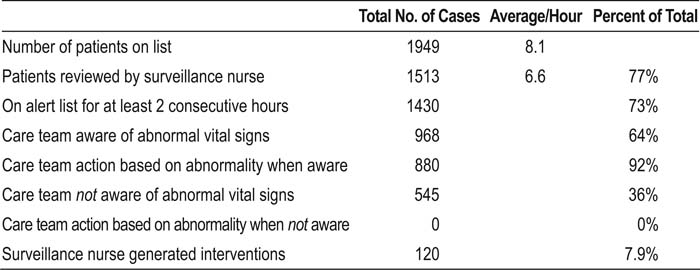Background:
Potentially avoidable deaths occur each year among hospital patients. A death is considered potentially avoidable when warning signs were present hours prior to death and when it was a result of a potentially reversible condition such as sepsis. In an effort to eliminate avoidable deaths, many hospitals have instituted rapid response teams (RRT). One of the potential weaknesses of most RRTs is that activation usually relies solely on human recognition of critically abnormal vital signs. This recognition process is not consistently reliable, and as a result some patients may not receive timely lifesaving interventions. Our research question for this pilot study was: does an electronically hourly generated list of patients with critically abnormal vital sign parameters identify critically ill patients not recognized as such by the patients' care team?
Methods:
An alert list of inpatients with critically abnormal vital signs, defined as SBP < 90, HR > 130, RR > 24, and SaO2 < 90%, was automatically electronically generated every hour on the hour. Patients in the CCU, in the ER, and on comfort care were automatically filtered from the list. The system was tested at our 336‐bed urban community‐based teaching hospital. The output of the query was an alert patient list that was viewed from within the early warning system (HER) by a surveillance nurse dedicated to this task. For each patient on the alert list, the surveillance nurse reviewed the chart within the EHR and could take any of the following actions: call the patient's nurse or MD, activate the RRT, and/or increase vital sign‐monitoring frequency.
Results:
The list was monitored for 240 hours over the 4‐week trial period. Table 1 summarizes the findings. Most significantly, the care team reliably took action 92% of the time when the primary nurse was aware of the critically abnormal vital sign. However when the primary nurse was unaware that a patient had a critically abnormal vital sign, no actions were taken.
Conclusions:
During the study period 36% of patients had critically abnormal vital signs not recognized by the team caring for the patient. The nurse may prevent underdetection of critically ill use of an electronic monitoring system along with actions generated by a surveillance patients and may reduce potentially avoidable deaths.
Author Disclosure:
B. Aaronson, none; M. Westley, none; M. Spohnholtz, none; L. Tyler, none; E. Dunning, none.

